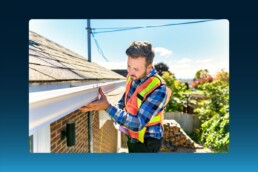As a homeowner, ensuring adequate insurance coverage for your property is paramount to protect against unexpected damages and losses. One crucial factor that can impact your homeowner’s insurance coverage is your roof’s age.
In this blog post, we’ll explore the relationship between the age of your roof and your insurance coverage, examining how insurers assess roof age, potential implications for coverage, and proactive measures homeowners can take to mitigate risks and ensure adequate protection for their homes.
Understanding Roof Age and Insurance Coverage
Roofs are vital to your home, protecting you and your family against the elements and maintaining the property’s structural integrity. However, as roofs age, they become more susceptible to wear and tear, deterioration, and damage from various factors such as weather, UV exposure, and environmental conditions.
Insurers consider the age and condition of a roof when determining coverage and premiums. A newer roof, typically less than 10 years old, is often seen as less risky and may qualify for lower premiums due to its reduced likelihood of damage or failure.
On the other hand, an older roof, nearing the end of its expected lifespan, may present higher risks of leaks, deterioration, and structural issues, leading insurers to adjust coverage terms and premiums accordingly.
Assessment of Roof Age
Insurers typically assess a roof’s age based on several factors, including:
Original Installation Date
The date of its original installation is often used to determine the roof’s age. Insurers may request documentation, such as building permits or installation invoices, to verify the roof’s age.
Material Lifespan
Different roofing materials have varying lifespans, with asphalt shingles typically lasting 15-30 years, metal roofs lasting 40-70 years, and clay or concrete tiles lasting 50-100 years. Insurers may consider the expected lifespan of the roofing material when assessing coverage.
Maintenance History
The roof’s maintenance history, including repairs, replacements, and inspections, can also influence how insurers evaluate its age and condition. Regular maintenance and upkeep may extend the roof’s lifespan and impact coverage terms.
Implications for Coverage
In this section, we’ll explore the implications of roof age on insurance coverage, including potential limitations, adjustments to premiums, and considerations for claims settlement.
Coverage Limitations
Some insurers may impose restrictions or exclusions on roof coverage beyond a certain age threshold. For example, coverage for roof damage due to wear and tear, aging, or pre-existing conditions may be limited or excluded from standard policies.
Premium Adjustments
Insurers may adjust premiums based on the age and condition of the roof. Older roofs are typically associated with higher premiums to reflect increased risk. Homeowners with newer roofs may qualify for discounts or lower premiums due to reduced risk exposure.
Claims Settlement
In the event of a roof-related insurance claim, the age and condition of the roof may influence the claims settlement process. Insurers may conduct inspections or assessments to determine the cause and extent of damage, considering factors such as roof age, maintenance history, and compliance with building codes.
Proactive Measures for Homeowners
While homeowner’s insurance provides essential coverage against unexpected damages and losses, taking proactive measures to mitigate risks and maintain your property can further enhance your security and peace of mind.
Let’s uncover the key proactive measures that can help you protect your property and financial security against unforeseen risks and challenges:
Regular Maintenance
Maintain your roof regularly by inspecting for signs of damage, leaks, or deterioration and addressing any issues promptly to prevent further damage. Cut back any branches that hang over your roof, and remove any moss growth.
Documentation
Keep records of roof repairs, maintenance activities, and inspections, including receipts, invoices, and inspection reports. This documentation can be valuable when filing insurance claims or negotiating coverage terms.
Upgrades and Improvements
Consider investing in roof upgrades or improvements, such as installing impact-resistant shingles, reinforcing roof structures, or enhancing drainage systems to reduce risks and enhance insurability.
Review and Compare Policies
Periodically review your homeowner’s insurance policy to understand coverage terms, exclusions, and limitations related to roof age and condition. In a claims situation, some carriers will only provide the actual cash value (depreciated value) once the roof hits a certain age. A better policy will provide full replacement cost. If you have replaced your roof, contact your agent, as some carriers may apply a discount to your policy premium. It is also good to have the correct year of the roof installation known to your agent so they have the correct information when remarketing your policy prior to renewal.
Schedule Professional Inspections
Regularly schedule professional roof inspections by licensed contractors or roofing specialists. These inspections can identify potential issues early on, such as loose shingles, deteriorating flashing, or signs of water damage. By addressing these issues promptly, homeowners can prevent minor problems from escalating into costly repairs or insurance claims.
Implement Preventive Maintenance Programs
Consider enrolling in preventive maintenance programs offered by roofing companies or insurance providers. These programs often include routine inspections, cleaning, and maintenance services to keep your roof in optimal condition.
By participating in these programs, homeowners can proactively address maintenance needs and prolong the lifespan of their roofs, ultimately reducing the risk of damage and insurance claims.
Key Takeaways
The age of your roof significantly impacts your homeowner’s insurance, influencing coverage availability, premiums, and claims settlement processes.
By taking proactive measures to mitigate risks, ensure adequate protection, and maintain insurability, homeowners can protect their homes and financial security against unforeseen roof-related damages and losses.

